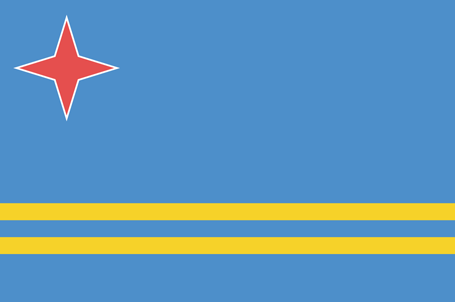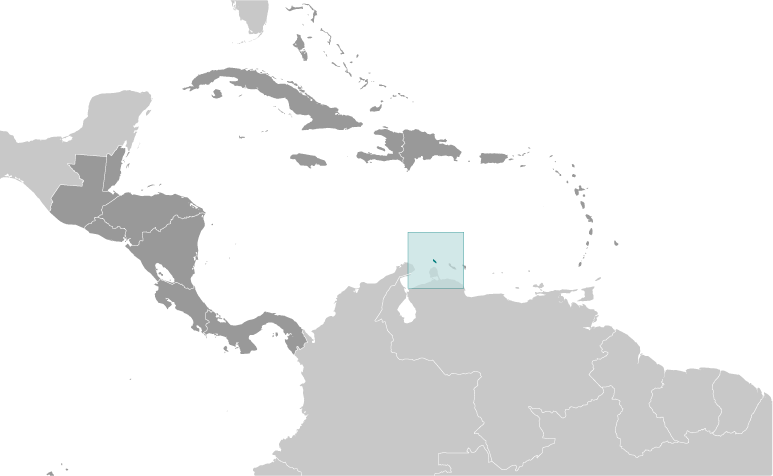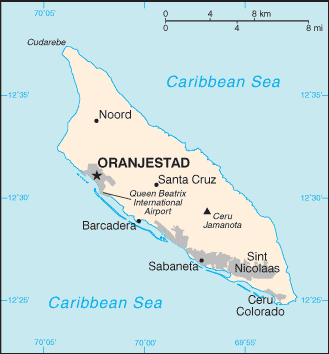



Central America and Caribbean :: ARUBA
Introduction :: ARUBA
-
Discovered and claimed for Spain in 1499, Aruba was acquired by the Dutch in 1636. The island's economy has been dominated by three main industries. A 19th century gold rush was followed by prosperity brought on by the opening in 1924 of an oil refinery. The last decades of the 20th century saw a boom in the tourism industry. Aruba seceded from the Netherlands Antilles in 1986 and became a separate, autonomous member of the Kingdom of the Netherlands. Movement toward full independence was halted at Aruba's request in 1990.
Geography :: ARUBA
-
Caribbean, island in the Caribbean Sea, north of Venezuela12 30 N, 69 58 WCentral America and the Caribbeantotal: 180 sq kmland: 180 sq kmwater: 0 sq kmcountry comparison to the world: 218slightly larger than Washington, DC0 km68.5 kmterritorial sea: 12 nmexclusive economic zone: 200 nmtropical marine; little seasonal temperature variationflat with a few hills; scant vegetationmean elevation: NAelevation extremes: lowest point: Caribbean Sea 0 mhighest point: Ceru Jamanota 188 mNEGL; white sandy beaches foster tourismagricultural land: 11.1%arable land 11.1%; permanent crops 0%; permanent pasture 0%forest: 2.3%other: 86.6% (2011 est.)NAmost residents live in or around Oranjestad and San Nicolaas; most settlements tend to be located on the less mountainous western side of the islandhurricanes; lies outside the Caribbean hurricane belt and is rarely threateneddifficulty in properly disposing of waste produced by large numbers of touristsa flat, riverless island renowned for its white sand beaches; its tropical climate is moderated by constant trade winds from the Atlantic Ocean; the temperature is almost constant at about 27 degrees Celsius (81 degrees Fahrenheit)
People and Society :: ARUBA
-
115,120 (July 2017 est.)country comparison to the world: 189noun: Aruban(s)adjective: Aruban; DutchDutch 82.1%, Colombian 6.6%, Venezuelan 2.2%, Dominican 2.2%, Haitian 1.2%, other 5.5%, unspecified 0.1% (2010 est.)Papiamento (official) (a creole language that is a mixture of Portuguese, Spanish, Dutch, English, and, to a lesser extent, French, as well as elements of African languages and the language of the Arawak) 69.4%, Spanish 13.7%, English (widely spoken) 7.1%, Dutch (official) 6.1%, Chinese 1.5%, other 1.7%, unspecified 0.4% (2010 est.)Roman Catholic 75.3%, Protestant 4.9% (includes Methodist 0.9%, Adventist 0.9%, Anglican 0.4%, other Protestant 2.7%), Jehovah's Witness 1.7%, other 12%, none 5.5%, unspecified 0.5% (2010 est.)0-14 years: 17.64% (male 10,189/female 10,115)15-24 years: 12.78% (male 7,405/female 7,307)25-54 years: 41.72% (male 23,117/female 24,906)55-64 years: 14.28% (male 7,664/female 8,773)65 years and over: 13.59% (male 6,132/female 9,512) (2017 est.)total dependency ratio: 44.6youth dependency ratio: 27elderly dependency ratio: 17.5potential support ratio: 5.7 (2015 est.)total: 39.3 yearsmale: 37.5 yearsfemale: 41.1 years (2017 est.)country comparison to the world: 561.27% (2017 est.)country comparison to the world: 8412.4 births/1,000 population (2017 est.)country comparison to the world: 1598.4 deaths/1,000 population (2017 est.)country comparison to the world: 828.7 migrant(s)/1,000 population (2017 est.)country comparison to the world: 12most residents live in or around Oranjestad and San Nicolaas; most settlments tend to be located on the less mountainous western side of the islandurban population: 41.1% of total population (2017)rate of urbanization: -0.1% annual rate of change (2015-20 est.)ORANJESTAD (capital) 29,000 (2014)at birth: 1.02 male(s)/female0-14 years: 1.01 male(s)/female15-24 years: 1.01 male(s)/female25-54 years: 0.93 male(s)/female55-64 years: 0.87 male(s)/female65 years and over: 0.64 male(s)/femaletotal population: 0.9 male(s)/female (2016 est.)total: 10.7 deaths/1,000 live birthsmale: 14 deaths/1,000 live birthsfemale: 7.4 deaths/1,000 live births (2017 est.)country comparison to the world: 131total population: 76.9 yearsmale: 73.9 yearsfemale: 80.1 years (2017 est.)country comparison to the world: 801.83 children born/woman (2017 est.)country comparison to the world: 148improved:urban: 98.1% of populationrural: 98.1% of populationtotal: 98.1% of populationunimproved:urban: 1.9% of populationrural: 1.9% of populationtotal: 1.9% of population (2015 est.)improved:urban: 97.7% of populationrural: 97.7% of populationtotal: 97.7% of populationunimproved:urban: 2.3% of populationrural: 2.3% of populationtotal: 2.3% of population (2015 est.)NANANAnote: active local transmission of Zika virus by Aedes species mosquitoes has been identified in this country (as of August 2016); it poses an important risk (a large number of cases possible) among US citizens if bitten by an infective mosquito; other less common ways to get Zika are through sex, via blood transfusion, or during pregnancy, in which the pregnant woman passes Zika virus to her fetus (2016)6.1% of GDP (2014)country comparison to the world: 41definition: age 15 and over can read and writetotal population: 97.5%male: 97.5%female: 97.5% (2015 est.)total: 14 yearsmale: 13 yearsfemale: 14 years (2012)total: 28.9%male: 29.9%female: 27.5% (2010 est.)country comparison to the world: 43
Government :: ARUBA
-
conventional long form: noneconventional short form: Arubaetymology: the origin of the island's name is unclear; according to tradition, the name comes from the Spanish phrase "oro huba" (there was gold), but in fact no gold was ever found on the island; another possibility is the native word "oruba," which means "well-situated"constituent country of the Kingdom of the Netherlands; full autonomy in internal affairs obtained in 1986 upon separation from the Netherlands Antilles; Dutch Government responsible for defense and foreign affairsparliamentary democracy (Legislature); part of the Kingdom of the Netherlandsname: Oranjestadgeographic coordinates: 12 31 N, 70 02 Wtime difference: UTC-4 (1 hour ahead of Washington, DC, during Standard Time)none (part of the Kingdom of the Netherlands)note: Aruba is one of four constituent countries of the Kingdom of the Netherlands; the other three are the Netherlands, Curacao, and Sint Maartennone (part of the Kingdom of the Netherlands)National Anthem and Flag Day, 18 March (1976)previous 1947, 1955; latest drafted and approved August 1985, enacted 1 January 1986 (regulates governance of Aruba but is subordinate to the Charter for the Kingdom of the Netherlands); note - in October 2010, following dissolution of the Netherlands Antilles, Aruba became a constituent country within the Kingdom of the Netherlands (2016)civil law system based on the Dutch civil codesee the Netherlands18 years of age; universalchief of state: King WILLEM-ALEXANDER of the Netherlands (since 30 April 2013); represented by Governor General Alfonso BOEKHOUDT (since 1 January 2017)head of government: Prime Minister Michiel "Mike" Godfried EMAN (since 30 October 2009)cabinet: Council of Ministers elected by the Legislature (Staten)elections/appointments: the monarchy is hereditary; governor general appointed by the monarch for a 6-year term; prime minister and deputy prime minister indirectly elected by the Staten for 4-year term; election last held on 27 September 2013 (next to be held by September 2017)election results: Michiel "Mike" Godfried EMAN (AVP) elected prime minister; percent of legislative vote - NAdescription: unicameral Legislature or Staten (21 seats; members directly elected in a single nationwide constituency by proportional representation vote; members serve 4-year terms)elections: last held on 22 September 2017 (next to be held in September 2021)election results: percent of vote by party AVP 39.8%, MEP 37.6%, POR 9.4%, RED 7.1%; seats by party - AVP 9, MEP 9, POR 2, RED 1highest court(s): Joint Court of Justice of Aruba, Curacao, Sint Maarten, and of Bonaire, Sint Eustatitus and Saba or "Joint Court of Justice" (sits as a 3-judge panel); final appeals heard by the Supreme Court, in The Hague, Netherlandsjudge selection and term of office: Joint Court judges appointed by the monarch for lifesubordinate courts: Courts in First InstanceAruban People's Party or AVP [Michiel "Mike" EMAN]Democratic Electoral Network or RED [L.R. CROES]People's Electoral Movement Party or MEP [Evelyn WEVER-CROES]Pueblo Orguyoso y Respeta or POR [O.E. ODUBER];; Real Democracy or PDR [Andin BIKKER]environmental groupsCaricom (observer), FATF, ILO, IMF, Interpol, IOC, ITUC (NGOs), UNESCO (associate), UNWTO (associate), UPUnone (represented by the Kingdom of the Netherlands); note - there is a Minister Plenipotentiary for Aruba at the Embassy of the Kingdom of the Netherlandsthe US does not have an embassy in Aruba; the Consul General to Curacao is accredited to Arubablue, with two narrow, horizontal, yellow stripes across the lower portion and a red, four-pointed star outlined in white in the upper hoist-side corner; the star represents Aruba and its red soil and white beaches, its four points the four major languages (Papiamento, Dutch, Spanish, English) as well as the four points of a compass, to indicate that its inhabitants come from all over the world; the blue symbolizes Caribbean waters and skies; the stripes represent the island's two main "industries": the flow of tourists to the sun-drenched beaches and the flow of minerals from the earthHooiberg (Haystack) Hill; national colors: blue, yellow, red, whitename: "Aruba Deshi Tera" (Aruba Precious Country)lyrics/music: Juan Chabaya 'Padu' LAMPE/Rufo Inocencio WEVERnote: local anthem adopted 1986; as part of the Kingdom of the Netherlands, "Het Wilhelmus" is official (see Netherlands)
Economy :: ARUBA
-
Tourism, petroleum bunkering, hospitality, and financial and business services are the mainstays of the small open Aruban economy.Tourism accounts for a majority of economic activity; as of 2014, over 1.7 million tourists visited Aruba annually, with the large majority of those from the US. The rapid growth of the tourism sector has resulted in a substantial expansion of other activities. Construction continues to boom, especially in the hotel sector.Aruba is heavily dependent on imports and is making efforts to expand exports to improve its trade balance. Almost all consumer and capital goods are imported, with the US, the Netherlands, and Panama being the major suppliers.In 2016, Citgo Petroleum Corporation, an indirect wholly owned subsidiary of Petroleos de Venezuela SA, and the Government of Aruba signed an agreement to restart Valero Energy Corp.'s former 235,000-b/d refinery . Tourism and related industries have continued to grow, and the Aruban government is working to attract more diverse industries. Aruba's banking sector continues to be a strong sector; unemployment has significantly decreased.$2.516 billion (2009 est.)$2.258 billion (2005 est.)$2.205 billion (2004 est.)country comparison to the world: 190$2.516 billion (2009 est.)2.4% (2005 est.)country comparison to the world: 119$25,300 (2011 est.)country comparison to the world: 75household consumption: 60.3%government consumption: 26.2%investment in fixed capital: 22.3%investment in inventories: 0%exports of goods and services: 70.2%imports of goods and services: -79% (2015 est.)agriculture: 0.4%industry: 33.3%services: 66.3% (2002 est.)aloes; livestock; fishtourism, petroleum transshipment facilities, bankingNA%51,610note: of the 51,610 workers aged 15 and over in the labor force, 32,252 were born in Aruba and 19,353 came from abroad; foreign workers are 38% of the employed population (2007 est.)country comparison to the world: 192agriculture: NA%industry: NA%services: NA%note: most employment is in wholesale and retail trade, followed by hotels and restaurants6.9% (2005 est.)country comparison to the world: 91NA%lowest 10%: NA%highest 10%: NA%revenues: $681.8 millionexpenditures: $781.3 million (2016 est.)27.1% of GDP (2016 est.)country comparison to the world: 102-4% of GDP (2016 est.)country comparison to the world: 13967% of GDP (2013)55% of GDP (2012)country comparison to the world: 55calendar year-0.9% (2016 est.)0.5% (2015 est.)country comparison to the world: 171% (31 December 2010)3% (31 December 2009)country comparison to the world: 1277.83% (31 December 2016 est.)8.25% (31 December 2015 est.)country comparison to the world: 108$1.257 billion (31 December 2016 est.)$1.151 billion (31 December 2015 est.)country comparison to the world: 147$2.328 billion (31 December 2016 est.)$2.126 billion (31 December 2015 est.)country comparison to the world: 147$1.848 billion (31 December 2016 est.)country comparison to the world: 150$283.1 million (2016 est.)$334.1 million (2015 est.)country comparison to the world: 182live animals and animal products, art and collectibles, machinery and electrical equipment, transport equipmentColombia 23.4%, US 19.8%, Netherlands 16.9%, Venezuela 13.9% (2016)$1.142 billion (2016 est.)$1.254 billion (2015 est.)country comparison to the world: 177machinery and electrical equipment, refined oil for bunkering and reexport, chemicals; foodstuffsUS 55.4%, Netherlands 12.6% (2016)$693.2 million (31 December 2014 est.)$666.4 million (31 December 2013 est.)country comparison to the world: 172Aruban guilders/florins per US dollar -1.79 (2016 est.)1.79 (2015 est.)1.79 (2014 est.)1.79 (2013 est.)1.79 (2012 est.)
Energy :: ARUBA
-
population without electricity: 11,364electrification - total population: 91%electrification - urban areas: 100%electrification - rural areas: 80% (2012)959 million kWh (2015 est.)country comparison to the world: 153891.9 million kWh (2015 est.)country comparison to the world: 1590 kWh (2016 est.)country comparison to the world: 960 kWh (2016 est.)country comparison to the world: 116296,000 kW (2015 est.)country comparison to the world: 15887.2% of total installed capacity (2015 est.)country comparison to the world: 690% of total installed capacity (2015 est.)country comparison to the world: 330% of total installed capacity (2015 est.)country comparison to the world: 15612.8% of total installed capacity (2015 est.)country comparison to the world: 570 bbl/day (2016 est.)country comparison to the world: 1020 bbl/day (2014 est.)country comparison to the world: 840 bbl/day (2014 est.)country comparison to the world: 870 bbl (1 January 2017 es)country comparison to the world: 1020 bbl/day (2014 est.)country comparison to the world: 1117,500 bbl/day (2015 est.)country comparison to the world: 1620 bbl/day (2014 est.)country comparison to the world: 1287,661 bbl/day (2014 est.)country comparison to the world: 1491 cu m (2013 est.)country comparison to the world: 1011 cu m (2013 est.)country comparison to the world: 1161 cu m (2013 est.)country comparison to the world: 571 cu m (2013 est.)country comparison to the world: 790 cu m (1 January 2014 es)country comparison to the world: 108900,000 Mt (2013 est.)country comparison to the world: 165
Communications :: ARUBA
-
total subscriptions: 35,000subscriptions per 100 inhabitants: 31 (July 2016 est.)country comparison to the world: 169total: 141,000subscriptions per 100 inhabitants: 126 (July 2016 est.)country comparison to the world: 185general assessment: modern fully automatic telecommunications systemdomestic: increased competition through privatization has increased mobile-cellular teledensity to over 125 per 100 persons; three mobile-cellular service providers are now licensedinternational: country code - 297; landing site for the PAN-AM submarine telecommunications cable system that extends from the US Virgin Islands through Aruba to Venezuela, Colombia, Panama, and the west coast of South America; extensive interisland microwave radio relay links (2016)2 commercial TV stations; cable TV subscription service provides access to foreign channels; about 19 commercial radio stations broadcast (2014).awtotal: 106,309percent of population: 93.5% (July 2016 est.)country comparison to the world: 172
Transportation :: ARUBA
-
number of registered air carriers: 3inventory of registered aircraft operated by air carriers: 19annual passenger traffic on registered air carriers: 2,120,578annual freight traffic on registered air carriers: 0 mt-km (2015)P4 (2016)1 (2013)country comparison to the world: 210total: 12,438 to 3,047 m: 1 (2017)major seaport(s): Barcadera, Oranjestadoil terminal(s): Sint Nicolaascruise port(s): Oranjestad
Military and Security :: ARUBA
-
no regular military forces (2011)defense is the responsibility of the Netherlands; the Aruba security services focus on organized crime and terrorism
Transnational Issues :: ARUBA
-
nonetransit point for US- and Europe-bound narcotics with some accompanying money-laundering activity; relatively high percentage of population consumes cocaine
